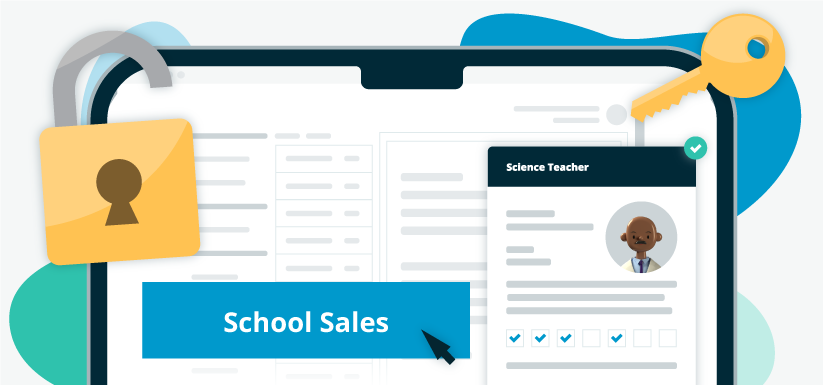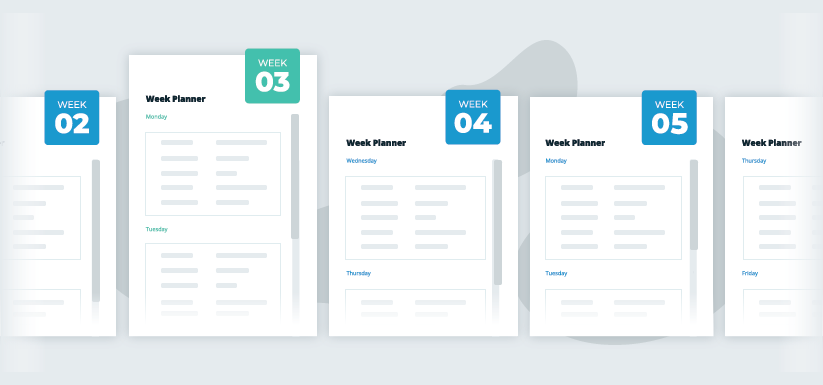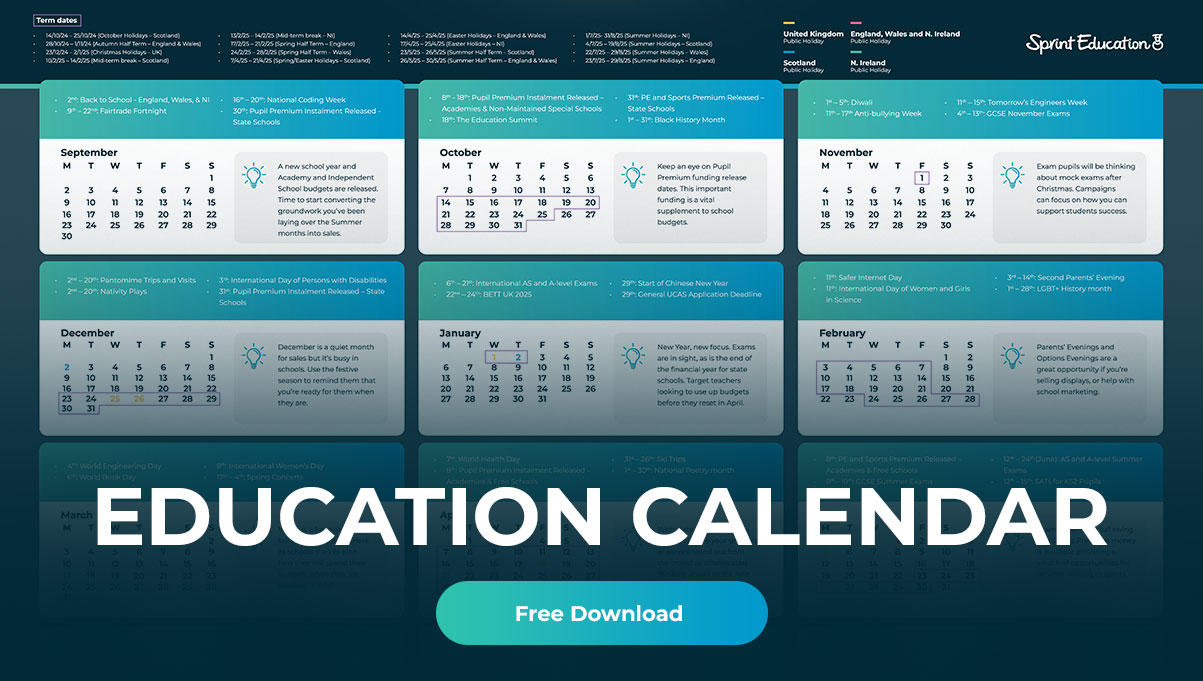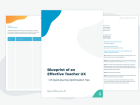How your edu-marketing can support school staff wellbeing
How your edu-marketing can support school staff wellbeing
Gain an insight into staff wellbeing to help you shape your marketing strategy into one that will help solve their problems and make you sales in the process.
Gain an insight into staff wellbeing to help you shape your marketing strategy into one that will help solve their problems and make you sales in the process.
It’s fair to say that over the last two years teachers and school staff have witnessed the biggest upheaval across the education sector in living memory.
Schools faced the impossible task of deciphering ever-changing government guidelines, often overnight, alongside trying to keep life as close to normal as possible for pupils, parents, and carers. Change and uncertainty can have a huge impact on mental health. When situations feel out of control, the body often responds as if we’re in physical danger. Our hearts and minds race as we struggle to adapt to changing plans and deal with the constant ‘what if?’.
Combined with increasing workloads for teachers and school staff, the pandemic has been a collective stressful event unlike any before.
Emotions influence customers' perceptions of quality and value, and purchasing decisions. This is particularly true when purchases are for work, where there could be major consequences if things go wrong, or when they’re making decisions about high-value products and services.
With that in mind, this guide is designed to give you an insight into the problems schools have been dealing with for the last two years, and how you can shape your next edu-marketing strategy into one that will offer your support – even if your product or service is completely unrelated to mental health and wellbeing.
An insight into the wellbeing of school staff
Results from our December 2020 survey
At the tail end of 2020, amidst the height of pandemic restrictions and the prospect of Christmas being cancelled, we conducted our first State of Selling to Schools survey.
We wanted to go right to the source and speak to those working in schools with pupils every day to get the most up-to-date insights into how schools were managing the unprecedented challenges of the year. Over 2,600 teachers and school staff responded to that first survey.
We asked teachers and school staff to rank their stress levels and estimate their stress levels before the pandemic began.
Before the pandemic, how would you rank your stress levels working within the education sector? (10 being the most stressed?)
Since the pandemic began, how would you rank your stress levels during 2020 working within the education sector?
Teachers and school staff ranked their stress levels at the end of 2020 at 7.8, with 10 being the most stressed. They also ranked their pre-pandemic stress levels at an average of 5.8. Looking back at the shape of 2020 for educators, this jump of 2 points isn’t overly surprising.
When the announcement that schools must close to the majority of pupils first came in on the 20th of March 2020, it was largely only Universities who had any experience with the delivery of remote teaching, with the expectation that older students are generally better equipped to self-regulate their own learning.
For Primary and Secondary schools, it was likely that the only experience teachers would have previously had using digital learning systems was to manage and monitor homework, but not deliver live lessons.
The message to schools, and the wider population at this stage of the pandemic, was to stay home to protect the NHS and put the safety of pupils and staff first. The early months of the pandemic saw people coming together to manage the first lockdown, and public support for key workers (including teachers) was celebrated on doorsteps across the country every Thursday with the ‘Clap for Carers’ social movement.
By the start of the new academic year, in September 2021, the sense that the pandemic was here to stay was taking hold.
Government guidelines regarding remote education had changed considerably by this stage in the year. During the first lockdown, there were no published remote learning expectations and schools were left to adapt as best as possible, with many schools still printing and supplying hard copies of work that parents were required to collect.
It wasn’t until October 2020 that the government introduced a legal duty on schools to provide “immediate access to remote education” for pupils off school because of COVID-19. Guidance detailing more precise expectations for schools for remote learning followed calls for clarity on the issue from teachers and teaching unions.
The introduction of the legal duty placed increasing pressure on teachers and school staff as they continued to deal with challenging conditions, delivering both digital and in-person learning simultaneously.
As part of the December 2020 survey, we also asked what their top priority was for 2021.
An incredible 67.9% of school staff told us that supporting the emotional and mental wellbeing of pupils and staff was their top priority, above reducing learning loss (62.1%) and improving attainment (61.8%).
This was amongst a background of various charities, schools, and parents speaking out about their concern for pupil and staff mental health, with experts in the media warning of a looming mental health crisis due to COVID-19.
Results from our December 2021 survey
When we conducted our second State of Selling to Schools survey in December 2021, we were keen to know how things had changed for teachers and school staff.
Did schools meet their goal of prioritising wellbeing? Did things get in the way? Or did they, perhaps, only focus on the wellbeing of their pupils?
3,210 teachers and school staff responded to our 2021 survey, giving us an even bigger snapshot into the stress levels in the education sector nearly two years into the pandemic.
Teachers and school staff ranked their stress levels at the end of 2021 at 6.5. Down from 2020 (7.8) but still higher than pre-pandemic levels (5.8).
Given that in December 2021, rates of the COVID-19 variant (Omicron) were rising dramatically and the gains made by the vaccination drive felt uncertain, it’s not surprising that teachers were still more stressed than usual.
Government guidelines were still poised to change at a moment’s notice and education was yet to return fully to ‘business as usual’.
Can we judge from this data whether staff received more support throughout 2021, with schools stepping up their efforts to facilitate more positive, happier, healthier working environments? Or were teachers beginning to get used to the change of pace, or looking forward to the possibility of putting the pandemic behind them in 2022?
In contrast, as part of the charity Education Support’s 2021 annual teacher wellbeing index study, 62% of the 3,300 school staff they surveyed said that the pandemic had contributed to poor mental health, up significantly from 33% in 2020, with work-life balance and excessive workload cited as the most common work-related issues for staff.
While there may not be clear evidence that wellbeing and mental have improved yet since the start of the pandemic, we can certainly conclude that there’s still work to be done to help teachers reduce their stress back to pre-COVID levels (or even lower).
That means there are plenty of opportunities for education businesses, just like yours, to help.
What can edu-businesses do to help?
Since we published our first State of Selling to Schools survey highlighting the high stress levels teachers were experiencing, many of our clients have swung into action with truly inspiring campaigns designed to support their customer base, with some equally inspiring opening and click-to-open rates to boot.
Example 1:
A client whose core product is designed to directly address the wellbeing of school staff began 2021 with renewed vigour. Having offered a unique free communication tool to potential customers in 2020 to help teachers and school staff voice their concerns with senior leaders, this client began a campaign in 2021 designed to gather insights in order to feed into a report that would be used to highlight the issue of school staff mental health and campaign for change.
The campaign received over 3,000 form submissions with an average open rate of 30.1% and click-to-open rate as high as 45%.
Example 2:
A Campus client who took a personal approach to their campaign, by sharing their experience as an ex-teacher, offered free practical tools to help school staff focus on their own wellbeing, in addition to their core product designed to support pupil wellbeing and mental health.
In 2021, their campaigns generated open rates as high as 38.1% and click-to-open rates of up to 52.7%.
What’s Campus? I hear you say. Campus is our complete selling-to-schools solution. You'll never need to search for teacher email addresses or school data again because Campus has all the data you'll ever need built-in and updated on a minute-by-minute basis. Plus, its integrated email marketing tools, selling to schools features and education insights module, will give you the power to deliver edu-marketing direct to your target education audience, generate more leads, and empower you to sell more to schools.
Example 3:
A client whose core offer is school visits provided free resources to take part in a hands-on, nationwide project, aiming to get pupils and school staff alike to enjoy the wellbeing benefits of nature, received over 800 sign-ups within 24 hours of us distributing their first campaign email.
All these clients worked hard to help schools address a key issue their customers were facing. Even if your product or service has nothing to do with wellbeing or mental health, there are plenty of smart ways that you can include this topic into your edu-marketing for the benefit of both school staff and your business.
3 top tips for creating edu-marketing to support school staff wellbeing
So what does this all mean for your business? Here are three top tips that will help your next outreach edu-marketing campaign connect with decision-makers and support school staff wellbeing.
1. Be mindful of their time and remember the 50-word rule
Work-load pressures have long been an issue for teachers and school staff. In 2019, a study by the University College London (UCL) found that one in four teachers in the UK work more than 60 hours a week – 12 hours above the limit set by the European Working Time Directive to protect employees from exploitation. The pressure of the pandemic has exacerbated this issue.
We know that teachers have been spending more time online during the pandemic than they usually would and are two times more likely to check their inboxes than usual.
While it’s tempting to pack edu-marketing emails full of content extolling the virtues of your product or service in order to make that sale, this could actually have the opposite effect.
We know, from data collected from over 17,000 successful campaigns, that less is often so much more!
Teachers and school staff have limited time. If you know they’re already interested in your product or service, then by all means pack your email full of information to seal the deal.
But, if your outreach campaign is targeting contacts who may never have heard of your solution, save their time and energy by keeping your message concise and full of impact.
Keep this in mind when you’re planning your next outreach campaign – teachers and school staff typically only read 50 words of an email before they decide to click or close, so make those 50 words count.
2. Offer your support – can you provide no-strings-attached free resources, trials, or training?
If the answer’s yes then this will not only help you win the attention of time-poor teachers and turn them into valuable leads, but it will also place you firmly in their good books.
Think back to example 3 of the previous chapter. The client’s core offering wasn’t related to wellbeing, but they created an engaging free project for schools to get involved in that led to 800 sign-ups, and potentially new loyal customers.
Particularly if your product or service is of high value, it’s essential to put the time and effort into building brand awareness and trust before you ask for a sale, so make sure any free offer of resources or help is well thought through and worth the customer’s time before hit send.
3. Be human!
To make sales you need to move your potential teacher customer successfully through your sales funnel, building their trust and assuring them that you can solve their problems and deliver on your promises.
To do that you need to build a relationship with them - because 65% of consumers believe that a good experience with a company has more influence over their purchase decision than advertising does. (Hubspot)
A good relationship begins in the very first email you send a potential teacher customer. If you make a good impression, then you’re off to a great start in helping to set your sales team up for success further down the line.
If you want your teacher leads to feel like valued individuals, then your marketing emails should reflect that and treat them as an individual. Of course, writing and sending a different email to every potential customer would be incredibly time-consuming. This is where personalisation becomes your most important marketing tool.
Of course, relationships are a two-way deal and teachers and school staff appreciate feeling like they’re dealing with a real person rather than a faceless corporation.
Emails signed off by a named contact give a more personal feel to a marketing email than one signed off by a business name, and tend to generate significantly higher direct responses.
The minimally designed, personal emails that we create for clients generate approximately 75% of a campaign’s responses when used in a strategy that includes designed emails.
What next?
If you’re not sure how to start putting these tips into practice, drop us a line.
We can manage every aspect of your summer strategy with our managed strategies plan and let you know all about how we’ve revolutionised edu-marketing with Campus – our complete selling-to-schools solution. Get in touch at info@sprint-education.co.uk or 01684 297373.
Tags
Education News
Email Teachers
Emailing Teachers
How to Sell to Teachers
Marketing to Teachers
Selling to Teachers
Similar Articles


Selling to Schools 101: The Ultimate Guide
Go from novice to pro with our education marketing guide designed to unlock success for your selling-to-schools solution.


Your Six-Week Edu-Marketing Countdown to the Summer Holidays
Get your free six-week marketing plan to boost your selling-to-schools strategy ahead of the summer holidays, and secure even more sales come September.


Expert marketing to schools support and solutions
Expert marketing to schools solutions
Email Head Teachers, Teachers, and Staff Inboxes
Email teachers and staff inboxes
Sell More to UK and Global Schools and Colleges
Sell more to schools and colleges

































